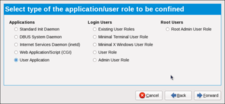SELinux Sandbox for Untrusted Programs
The security framework SELinux is set to offer a Sandbox in which applications deemed insecure can be partitioned off from other system areas.
Red Hat colleagues Dan Walsh and Eric Paris have designed an additional security tool. SELinux project leader Walsh describes the functionality and development of this tool in a detailed blog entry. The main idea: for SELinux to limit the actions an application can perform and to confine untrusted binaries. This way, users should be able to work with programs and data that are not considered 100% secure.
The developers were inspired to create a sandbox to execute these security measures using the SELinux policies via a query on the Linux core list. Walsh describes: "The bug report talked about confining grep, awk, ls ... The idea was couldn't we stop the grep or the mv command from suddenly opening up a network connection and copying off my /etc/shadow file to parts unknown.“ Regarding further application areas, Walsh sees GRID jobs as potential danger, they might become Spam Bots or attack systems in some other form.
 The Sandbox is just ten steps away: Dan Walsh chose "User Applications“ for the Sandbox because the security tool is intended for the user as well as the administrator.
The Sandbox is just ten steps away: Dan Walsh chose "User Applications“ for the Sandbox because the security tool is intended for the user as well as the administrator.
According to Walsh, only 10 clicks were needed to write the policy with the GUI program from Fedora 11. He delivers interested parties precise instructions. In addition to the policy, the “usr/bin/sandbox” tool was written in order to route contents into the Sandbox. One issue with the current version has not yet been fully dealt with: “My current intention with sandbox is not to handle X Apps, since these apps want to write all over the home directory ~/.gconf, ~/gnome., ~/.config ... and all over /tmp, along with use privs to talk to the X Server. I have some ideas on this for the future that I hope to experiment with.”
In a message on the Linux kernel list, Eric Paris introduces a simple application example and invites users to share their experiences. “Check it out, SELinux confinement made easy."
Subscribe to our Linux Newsletters
Find Linux and Open Source Jobs
Subscribe to our ADMIN Newsletters
Support Our Work
Linux Magazine content is made possible with support from readers like you. Please consider contributing when you’ve found an article to be beneficial.

News
-
Parrot OS Switches to KDE Plasma Desktop
Yet another distro is making the move to the KDE Plasma desktop.
-
TUXEDO Announces Gemini 17
TUXEDO Computers has released the fourth generation of its Gemini laptop with plenty of updates.
-
Two New Distros Adopt Enlightenment
MX Moksha and AV Linux 25 join ranks with Bodhi Linux and embrace the Enlightenment desktop.
-
Solus Linux 4.8 Removes Python 2
Solus Linux 4.8 has been released with the latest Linux kernel, updated desktops, and a key removal.
-
Zorin OS 18 Hits over a Million Downloads
If you doubt Linux isn't gaining popularity, you only have to look at Zorin OS's download numbers.
-
TUXEDO Computers Scraps Snapdragon X1E-Based Laptop
Due to issues with a Snapdragon CPU, TUXEDO Computers has cancelled its plans to release a laptop based on this elite hardware.
-
Debian Unleashes Debian Libre Live
Debian Libre Live keeps your machine free of proprietary software.
-
Valve Announces Pending Release of Steam Machine
Shout it to the heavens: Steam Machine, powered by Linux, is set to arrive in 2026.
-
Happy Birthday, ADMIN Magazine!
ADMIN is celebrating its 15th anniversary with issue #90.
-
Another Linux Malware Discovered
Russian hackers use Hyper-V to hide malware within Linux virtual machines.
